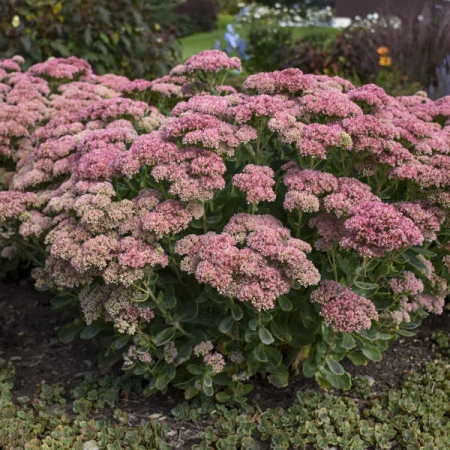Sedum (Autumn Stonecrop)
×
Color Name: Autumn Joy
'Autumn Joy,' is a stunning perennial plant that brings a burst of late-season color to gardens. With thick succulent-like leaves and sturdy stems, this plant boasts clusters of star-shaped flowers that start as rosy pink buds and gradually mature into rich coppery tones, eventually fading to a beautiful rusty red in the fall. Loved for its resilience and ability to thrive in various conditions, Autumn Joy Sedum is a favorite among gardeners, attracting butterflies and bees while adding a touch of vibrant warmth to autumn landscapes.
Tall, upright sedums form substantial clumps of foliage which can be substituted for shrubs in the landscape. Their stout, sturdy stems support the massive flower heads which develop in summer and burst into bloom in fall. If left standing, they provide winter interest and food for birds.
Growing Tips: Sedum is one of the most popular perennials grown in American gardens because it is very easy to grow and hardy in most areas of the country. Because of its thick, succulent leaves which can store water, sedum is drought tolerant. It should be sited in average to poor soil that is well-drained. Plants grown in rich soil tend to be lanky and open. Most varieties should be grown in full sun to light shade. The lower growing types, however, will survive in partial shade. This plant is not usually bothered by pests or diseases. The seed heads of the taller varieties provide excellent winter interest and food for birds. Remove them in spring when the new growth begins to show.
Photo courtesy of Walters Garden, Inc.
'Autumn Joy,' is a stunning perennial plant that brings a burst of late-season color to gardens. With thick succulent-like leaves and sturdy stems, this plant boasts clusters of star-shaped flowers that start as rosy pink buds and gradually mature into rich coppery tones, eventually fading to a beautiful rusty red in the fall. Loved for its resilience and ability to thrive in various conditions, Autumn Joy Sedum is a favorite among gardeners, attracting butterflies and bees while adding a touch of vibrant warmth to autumn landscapes.
Tall, upright sedums form substantial clumps of foliage which can be substituted for shrubs in the landscape. Their stout, sturdy stems support the massive flower heads which develop in summer and burst into bloom in fall. If left standing, they provide winter interest and food for birds.
Growing Tips: Sedum is one of the most popular perennials grown in American gardens because it is very easy to grow and hardy in most areas of the country. Because of its thick, succulent leaves which can store water, sedum is drought tolerant. It should be sited in average to poor soil that is well-drained. Plants grown in rich soil tend to be lanky and open. Most varieties should be grown in full sun to light shade. The lower growing types, however, will survive in partial shade. This plant is not usually bothered by pests or diseases. The seed heads of the taller varieties provide excellent winter interest and food for birds. Remove them in spring when the new growth begins to show.
Photo courtesy of Walters Garden, Inc.
|
Flower Color: Pink/Red Shades Foliage Color: Green Shades
Height: 20 to 24 Inches Spread: 18 to 24 Inches Hardy in Zone: 4, 5, 6, 7 |
Blooms: Fall Late Summer
Foliage Season: All Season |
Growth Rate |
Medium
|
Attributes |
Container Dried Flower Border Cut Flower or Foilage Drought Tolerant Easy to Grow Landscapes Mass Planting Salt Tolerant
|








